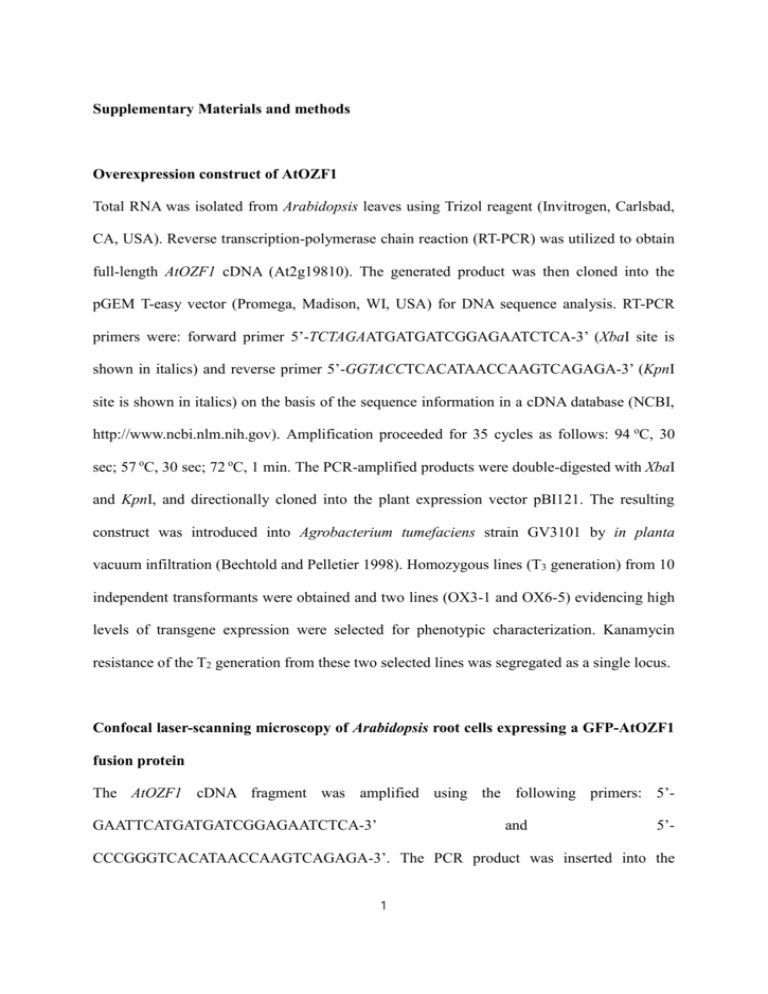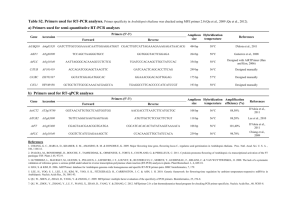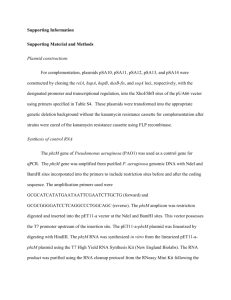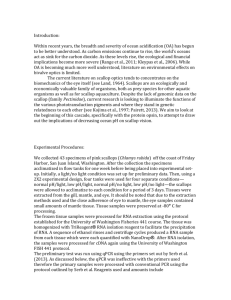RNA gel blot analysis - Springer Static Content Server
advertisement

Supplementary Materials and methods Overexpression construct of AtOZF1 Total RNA was isolated from Arabidopsis leaves using Trizol reagent (Invitrogen, Carlsbad, CA, USA). Reverse transcription-polymerase chain reaction (RT-PCR) was utilized to obtain full-length AtOZF1 cDNA (At2g19810). The generated product was then cloned into the pGEM T-easy vector (Promega, Madison, WI, USA) for DNA sequence analysis. RT-PCR primers were: forward primer 5’-TCTAGAATGATGATCGGAGAATCTCA-3’ (XbaI site is shown in italics) and reverse primer 5’-GGTACCTCACATAACCAAGTCAGAGA-3’ (KpnI site is shown in italics) on the basis of the sequence information in a cDNA database (NCBI, http://www.ncbi.nlm.nih.gov). Amplification proceeded for 35 cycles as follows: 94 oC, 30 sec; 57 oC, 30 sec; 72 oC, 1 min. The PCR-amplified products were double-digested with XbaI and KpnI, and directionally cloned into the plant expression vector pBI121. The resulting construct was introduced into Agrobacterium tumefaciens strain GV3101 by in planta vacuum infiltration (Bechtold and Pelletier 1998). Homozygous lines (T3 generation) from 10 independent transformants were obtained and two lines (OX3-1 and OX6-5) evidencing high levels of transgene expression were selected for phenotypic characterization. Kanamycin resistance of the T2 generation from these two selected lines was segregated as a single locus. Confocal laser-scanning microscopy of Arabidopsis root cells expressing a GFP-AtOZF1 fusion protein The AtOZF1 cDNA fragment was amplified using the following primers: 5’and GAATTCATGATGATCGGAGAATCTCA-3’ 5’- CCCGGGTCACATAACCAAGTCAGAGA-3’. The PCR product was inserted into the 1 pEGAD vector at the EcoRI and SmaI cloning sites. The nucleotide sequence of the new construct was confirmed via DNA sequencing. The root cells from green fluorescent protein (GFP)-AtOZF1 overexpressing lines were mounted on microscope slides and examined using a LSM510 laser-scanning confocal microscope (Carl Zeiss, Jena, Germany) equipped with a 40x, 1.2 NA water immersion objectives. GFP excitation and emission wavelengths were 488 and 505–545 nm, respectively. Images were acquired using the microscope manufacturer’s software (Ver. 2.5) and adjusted with Photoshop 5.5 (Adobe Systems, San Jose, CA). Quantitative real-time polymerase chain reaction (PCR) Quantitative real-time PCR (qPCR) was carried out with a Rotor-Gene 6000 quantitative PCR apparatus (Corbett Research, Mortlake, NSW, Australia), and the results were analyzed using RG6000 1.7 software (Corbett Research). Total RNA was extracted from the oxidative stress-treated 14-day-old Arabidopsis seedlings using a RNeasy Plant Mini kit (QIAGEN, Valencia, CA, USA). qPCR was carried out using the SensiMix One-Step kit (Quantance, London, UK). Arabidopsis Actin8 was used as the internal control. Quantitative analysis was carried out using the Delta Delta CT method (Livak & Schmittgen, 2001). Each sample was run in three independent experiments. The reaction primers utilized were as follows: - for qPCR of AtOZF1 (At2g19810), upstream 5’-TCGTCTAACTCGCCGCCGGT-3’ and downstream 5’-CCCGGGTCACATAACCAAGTCAGAGA-3’; - for qPCR of AtOZF2 (At4g29190), upstream 5’-ATGATGATCGGAGAAACTCG-3’ and downstream 5’-ACACGGCTGAGTACGGTAAC-3’; - for qPCR of AtGSTU5 ATGGCTGAGAAAGAAGAAGTGAAGC-3’ TTAAGAAGATCTCACTCTCTCTGCC-3’; 2 (At2g29450), and upstream downstream 5’5’- - for qPCR of APX1 (At1g07890), upstream 5’-ATGACGAAGAACTACCCAACC-3’ and downstream 5’-TTAAGCATCAGCAAACCCAA-3’; - for qPCR of Actin8 (At1g49240), upstream 5’-CCTTGCTGGTCGTGACCTTACTGA-3’ and downstream 5’-CTCTCAGCACCGATCGTGATCACT-3’. Measurement of chlorophyll content and MDA levels Chlorophyll contents of detached leaves of 4-week-old plants were determined by measuring the absorbance of extracts prepared with 80% acetone (Arnon 1949). The level of membrane damage was determined by measuring malondialdehyde (MDA) as an end product of membrane lipid peroxidationas previously described (Heath and Packer 1968). The samples were homogenized in 10% (w/v) trichloroacetic acid (TCA) solution on ice. The homogenate was centrifuged for 5 min at 10,000 rpm and the supernatant was collected. One milliliter of 10% (w/v) TCA containing 0.6% (w/v) thiobarbituric acid (TBA) was added to a 0.5 ml aliquot of the supernatant. The mixture was then maintained for 15 min in a boiling water bath and then quickly cooled on ice. The absorbance of the colored supernatant was measured at 532 nm and was corrected for non-specific absorbance at 600 nm. The absorbance at 600 nm was subtracted from that at 532 nm, and the MDA content was calculated by using the extinction coefficient of 155 mM-1 cm-1 and expressed as nmol/g fresh weight (Fu and Huang 2001). Extraction of RNA and RT-PCR Total RNA was extracted from the frozen samples using the Plant RNeasy extraction kit (Qiagen, Valencia, CA). To remove any residual genomic DNA in the preparation, the RNA was treated with RNase-free DNase I in accordance with the manufacturer’s instructions 3 (Qiagen). The concentration of RNA was quantified accurately via spectrophotometric measurements, and 5 g of total RNA was separated on 1.2% formaldehyde agarose gels to check their concentration and monitor their integrity. RT-PCR was employed to measure the levels of AtOZF1 expression in T-DNA mutant plants. Five hundred nanograms of total RNA was used in the RT-PCR reaction, together with the following primers: AtOZF1 (GenBank accession no. NP_179571), forward (5’-TCGTCTAACTCGCCGCCGGT-3’) and reverse (5’CCCGGGTCACATAACCAAGTCAGAGA-3’). Actin8 (GenBank accession no. NP_175350), forward (5’-CCTTGCTGGTCGTGACCTTACTGA-3’) and reverse (5’CTCTCAGCACCGATCGTGATCACT-3’). After 27 PCR cycles of amplification, 20 µl of each RT-PCR product was loaded onto a 1.2% (w/v) agarose gel to visualize the amplified DNAs. Molecular cloning of RD29A and RD29B genes Total RNA was isolated from Arabidopsis leaves using Trizol reagent (Invitrogen). RT-PCR was used to obtain RD29A, and RD29B cDNAs. The generated product was cloned into the pGEM T-easy vector (Promega, Madison, WI) for DNA sequence analysis. The RT-PCR primers were as follows: - for the construction of RD29A (GenBank accession no. NP_200044), upstream 5’and AGGAACCACCACTCAACACAC-3’ downstream 5’- CGTCATCATCATCATCTTCTTC-3’. - for the construction of RD29B (GenBank accession no. NP_200043), upstream 5’and GAGCAAGCAGAAGAACCAATCA-3’ CATCATCATCATCTTCCACATCG-3’. 4 downstream 5’- RNA gel blot analysis Total RNA was isolated from seedlings grown according to standard protocols as indicated. For Northern blots, total RNA was separated by 1.2% (w/v) agarose gel electrophoresis in the presence of formaldehyde and transferred to positively charged nylon membranes (Roche, Indianapolis, IN). Hybridization and washes were conducted under high stringency conditions according to standard procedures using 32P-radiolabeled probes. Supplementary References Arnon DI (1949) Copper enzymes in isolated chloroplasts. Polyohenoloxidase in Beta vulgaris. Plant Physiol 24:1-15 Bechtold N, Pelletier G (1998) In planta Agrobacterium-mediated transformation of adult Arabidopsis thaliana plants by vacuum infiltration. Methods Mol Biol 82:259-266 Fu J, Huang B (2001) Involvement of antioxidants and lipid peroxidation in the adaptation of two cool-season grasses to localized drought stress. Environ Exp Bot 45:105-114 Heath RL, Packer L (1968) Photoperoxidation in isolated chloroplasts: I. Kinetics and stoichiometry of fatty acid peroxidation. Arch Biochem Biophys 125:189-198 Livak KJ, Schmittgen TD (2001) Analysis of relative gene expression data using real-time quantitative PCR and the 2-CT method. Methods 25: 402-408 5







